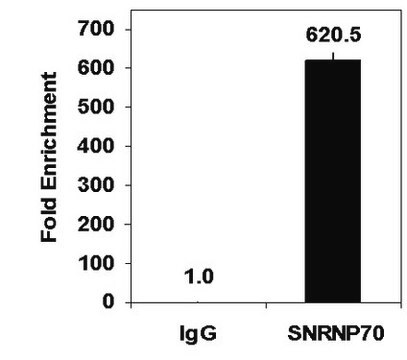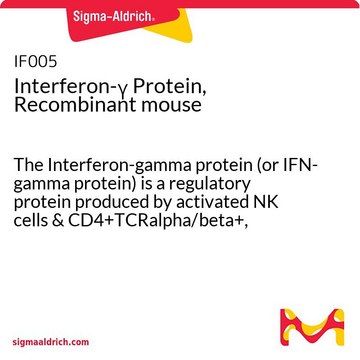407303
γ-Interferon, Mouse, Recombinant, E. coli
Synonyme(s) :
IFNG, Type II IFN
About This Item
Produits recommandés
Description
Merck USA index - 14, 4992
Niveau de qualité
Essai
≥95% (SDS-PAGE)
Forme
liquid
Fabricant/nom de marque
Calbiochem®
Conditions de stockage
OK to freeze
avoid repeated freeze/thaw cycles
Solubilité
water: soluble
Numéro d'accès Protein ID
Numéro d'accès UniProt
Conditions d'expédition
wet ice
Température de stockage
−70°C
Informations sur le gène
mouse ... Ifng(15978)
Description générale
Recombinant, mouse γ-interferon, consisting of 134 amino acids, expressed in E. coli as a single, non-glycosylated polypeptide.
Application
Actions biochimiques/physiologiques
Antigen Processing and Presentation: IFN-γ enhances the expression of molecules involved in antigen presentation. This helps in the efficient activation of T cells, leading to the initiation of adaptive immunity.
Reactive Oxygen Species (ROS): IFN-γ stimulates the production of ROS by promoting the assembly of NADPH oxidase subunits. These ROS possess strong microbicidal effects, aiding in the defense against invading pathogens.
Autophagy: IFN-γ induces the expression of proteins involved in autophagy, facilitating the clearance of intracellular pathogens and contributing to immune defense.
Apoptosis: IFN-γ triggers apoptotic cell death by increasing the expression of molecules associated with the apoptotic pathway.
Cell Migration and Leukocyte Traffic: IFN-γ promotes the expression of chemokines and adhesion molecules, facilitating immune cell migration and contributing to the initiation of inflammatory responses.
Antiviral Mediators: By inducing the expression of various antiviral proteins, IFN-γ counteracts viral infections at multiple stages of the viral life cycle.
Avertissement
Forme physique
Notes préparatoires
Reconstitution
Autres remarques
Familletti, P.C., et al. 1981. Methods Enzymol. 78, 387.
Informations légales
Code de la classe de stockage
12 - Non Combustible Liquids
Classe de danger pour l'eau (WGK)
WGK 2
Point d'éclair (°F)
Not applicable
Point d'éclair (°C)
Not applicable
Certificats d'analyse (COA)
Recherchez un Certificats d'analyse (COA) en saisissant le numéro de lot du produit. Les numéros de lot figurent sur l'étiquette du produit après les mots "Lot" ou "Batch".
Déjà en possession de ce produit ?
Retrouvez la documentation relative aux produits que vous avez récemment achetés dans la Bibliothèque de documents.
Notre équipe de scientifiques dispose d'une expérience dans tous les secteurs de la recherche, notamment en sciences de la vie, science des matériaux, synthèse chimique, chromatographie, analyse et dans de nombreux autres domaines..
Contacter notre Service technique








